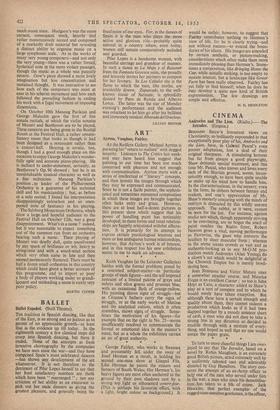ART -
Ayrton, Vaughan, Fairley.
AT the Redfern Gallery Michael Ayrton is pursuing his "return to realism" with dogged tenacity. Listeners to The Critics last week- end may have heard him suggest that painting in our time has been too much concerned with pleasure and not enough with communication. Ayrton starts with a series of intellectual or "literary" concepts, and then invents the images through which they may be expressed and communicated. Since he is not a facile painter, the sophisti- cated and sometimes mannered composition in which these images are brought together often lacks unity and grace. However, there are at least half-a-dozen pictures in this present show which suggest that his power of handling paint has noticeably developed; in them forms and tonal relation- ships are happily articulated without affecta- tion. It is primarily for its attempt to express certain psychological tensions and more or less ambiguous human relationships, however, that Ayrton's work is of interest, and in this respect too his new exhibition seems to me to mark an advance.
Keith Vaughan (at the Leicester Galleries) battles with the formal problems. posed by a restricted subject-matter—in particular groups of male figures—and the self-imposed restraint of a limited palette of greys and ochres and olive greens and prussian blue, with an occasional flash of orange-yellow. His painting shows signs of struggle—but as Cezanne's bathers carry the signs of struggle, or as the early works of Matisse and the analytical cubists, which it often resembles, shows signs of struggle. Some- times the motivation of his figures—for example that on the right in No. 25—seems insufficiently resolved to communicate the formal or emotional idea in the painter's mind, but as a whole the exhibition carries
an air of great authority.
*
George Fairley, who works in Swansea and presumably fell under the sway of Josef Herman as a result, is holding his second one-man show at Gimpel Fils. Like Herman he paints the miners and farmers of South Wales; like Herman's, his heavy figures are most often anchored to the ground by their own shadows cast by a strong top light or silhouetted contre-jour. (This is perhaps his favourite effect, with a fight, bright colour as background.) It would be unfair, however, to suggest that Fairley contributes nothing to Herman's view of life, for he is clearly trying—and not without success—to extend the boun- daries of his idiom. His images are amended by certain aesthetic, or picture-making, considerations which often make them more immediately pleasing than Herman's. Some- times a composition, like Bringing. Home the Cup, while initially striking, is too empty to sustain interest, but a landscape like Gower Farm has been really observed. Fairley has yet fully to find himself; when he does he may develop a quite new kind of British expressionism. The few drawings are simple and effective.
M. H. MIDDLETON


































 Previous page
Previous page